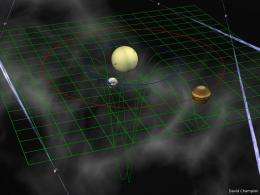A new way to weigh planets

An international CSIRO-led team of astronomers has developed a new way to weigh the planets in our Solar System - using radio signals from the small spinning stars called pulsars.
“This is first time anyone has weighed entire planetary systems - planets with their moons and rings,” said team leader Dr David Champion from Germany’s Max-Planck-Institut für Radioastronomie.
“And we’ve provided an independent check on previous results, which is great for planetary science.”
Measurements of planet masses made this new way could feed into data needed for future space missions.
Until now, astronomers have weighed planets by measuring the orbits of their moons or of spacecraft flying past them. That’s because mass creates gravity, and a planet’s gravitational pull determines the orbit of anything that goes around it - both the size of the orbit and how long it takes to complete.
The new method is based on corrections astronomers make to signals from pulsars - small spinning stars that deliver regular ‘blips’ of radio waves.
The Earth is travelling around the Sun, and this movement affects exactly when pulsar signals arrive here.
To remove this effect, astronomers calculate when the pulses would have arrived at the Solar System’s centre of mass, or barycentre, around which all the planets orbit.
Because the arrangement of the planets around the Sun changes all the time, the barycentre moves around too.
To work out its position, astronomers use both a table (called an ephemeris) of where all the planets are at a given time, and the values for their masses that have already been measured.
CSIRO Astronomy and Space Science (CASS) researcher, Dr Dick Manchester, says that if these figures are slightly wrong, and the position of the barycentre is slightly wrong, then a regular, repeating pattern of timing errors appears in the pulsar data.
“For instance, if the mass of Jupiter and its moons is wrong, we see a pattern of timing errors that repeats over 12 years, the time Jupiter takes to orbit the Sun,” Dr Manchester said.
“But if the mass of Jupiter and its moons is corrected, the timing errors disappear. This is the feedback process that the astronomers have used to determine the planets’ masses.”
Data from a set of four pulsars have been used to weigh Mercury, Venus, Mars, Jupiter and Saturn with their moons and rings. Most of these data were recorded by CSIRO’s Parkes radio telescope in eastern Australia, with some contributed by the Arecibo telescope in Puerto Rico and the Effelsberg telescope in Germany.
The masses were consistent with those measured by spacecraft. The mass of the Jovian system, 9.547921(2) x 10-4 times the mass of the Sun, is significantly more accurate than the mass determined from the Pioneer and Voyager spacecraft, and consistent with, but less accurate than, the value from the Galileo spacecraft.
The new measurement technique is sensitive to a mass difference of two hundred thousand million million tonnes - just 0.003 per cent of the mass of the Earth, and one ten-millionth of Jupiter’s mass.
CASS scientist Dr George Hobbs says that, in the short term, spacecraft will continue to make the most accurate measurements for individual planets.
”But the pulsar technique will be the best for planets not being visited by spacecraft, and for measuring the combined masses of planets and their moons,” Dr Hobbs said,
Repeating the measurements would improve the values even more. If astronomers observed a set of 20 pulsars over seven years they’d weigh Jupiter more accurately than spacecraft have. Doing the same for Saturn would take 13 years.
The head of the ‘Fundamental �鶹��Ժics in Radio Astronomy’ research group at the Max-Planck-Institut für Radioastronomie, Professor Michael Kramer, says astronomers need this accurate timing because they are using pulsars to hunt for gravitational waves predicted by Einstein’s general theory of relativity.
“Finding these waves depends on spotting minute changes in the timing of pulsar signals, and so all other sources of timing error must be accounted for, including the traces of Solar System planets,” Professor Kramer said.
More information: "Measuring the mass of Solar-System planets using pulsar timing" - D.J. Champion et al. Accepted for publication in the Astrophysical Journal.
Provided by CSIRO




















